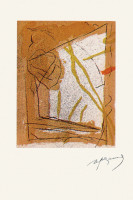
Details
Artist
Styles
// Albert Ràfols-Casamada's Laberint-1 (1988) is an etching that delves into the concept of a maze or labyrinth, a recurring theme in his abstract work. This limited edition print features winding, layered lines in soft gray and deep purple tones, weaving through each other to create a sense of enclosure and movement. Hints of green punctuate the composition, adding vibrancy and directing the viewer's eye through the winding paths. The artwork conveys a sense of introspection and exploration, as if inviting the viewer to trace the lines and find their own path within the layered forms. Laberint-1 exemplifies Ràfols-Casamada’s poetic abstraction, blending form and color in a way that evokes depth and mystery.
Laberint-1 , 1988
form
Medium
Size
56 x 38 cm
- Inches
- Centimeters
Edition
Price
- USD
- EUR
- GBP
Details
Artist
Styles
// Albert Ràfols-Casamada's Laberint-1 (1988) is an etching that delves into the concept of a maze or labyrinth, a recurring theme in his abstract work. This limited edition print features winding, layered lines in soft gray and deep purple tones, weaving through each other to create a sense of enclosure and movement. Hints of green punctuate the composition, adding vibrancy and directing the viewer's eye through the winding paths. The artwork conveys a sense of introspection and exploration, as if inviting the viewer to trace the lines and find their own path within the layered forms. Laberint-1 exemplifies Ràfols-Casamada’s poetic abstraction, blending form and color in a way that evokes depth and mystery.
- Recently Added
- Price (low-high )
- Price (high-low )
- Year (low-high )
- Year (high-low )
Albert Ràfols-Casamada
Portfolio 12th Anniversary Of Galeria Joan Prats , 1988
Limited Edition Print
Lithograph
EUR 500
What is Gestural?
Gestural art is a term that describes painting with freely sweeping brushstrokes. The primary goal of gestural art is to allow the artist to physically express emotional impulses. The varied, yet expressive paint marks are intended to convey the artist's inner thoughts and emotions, which viewers are believed to understand through the dynamic and spontaneous application of paint.





























































